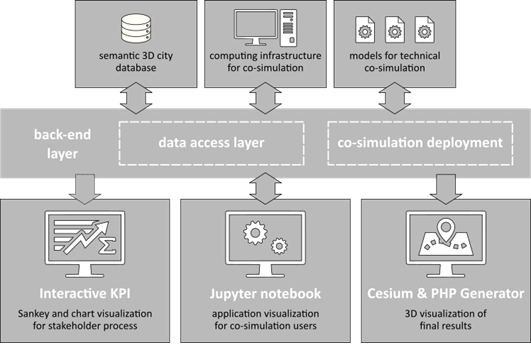Energy Informatics 2020 : Tools & Methods Workshop
About
The EU project IntegrCiTy focused on the decision-support for the planning of multi-energy grids in urban areas by developing a modular platform that provides tools for all phases of the municipal energy planning process. This includes support for the identification of relevant goals for all stakeholders, the development of suitable concepts based on these goals as well as system design and validation of potential solutions. IntegrCiTy’s approach explores and facilitates the understanding of how to implement sector coupling and network convergence (or interoperability) in practice, based on multi-energy scenarios and robust and reliable KPIs.
Within this context, the Energy Informatics 2020: Tools & Methods Workshop aims at showcasing selected parts of the IntegrCiTy platform, in order to demonstrate the value of this approach for practical applications in municipal energy planning in general and multi-energy application on district level in particular.
Workshop Topics
In the workshop, members of IntegrCiTy’s research team will explain and demonstrate selected parts of the IntegrCiTy platform:
- Interactive KPI tool: support for fact-based discussions among stakeholders during the conceptualization phase (Diane von Gunten, CREM)
- ZerOBNL co-simulation environment: support for simulation-based design and validation (Monica Arnaudo, KTH)
- IntegrCiTy Data Access Layer: support for semantic 3D city databases as hub for integrated and harmonized information (Edmund Widl, AIT)
Background Information
The IntegrCiTy platform comprises a toolchain of front-end applications (GUIs) that focus directly on the specific needs of the individual phases of a municipal energy planning process. For instance, the Interactive KPI tool aims at providing fact-based support for discussions among stakeholders during the conceptualization phase. By calculating KPIs and interactive Sankey diagrams of energy flows in real-time, this visual exploration tool allows to quickly explore different scenarios, and stakeholders can test and receive feedback on their preferred options. This direct feedback helps to streamline the discussions, to avoid unrealistic scenarios, and to explore innovative scenarios without the risk of losing time and/or money.
The second part of the IntegrCiTy platform is an underlying service management layer (back-end layer), which provides common resources and functionality for all front-end applications of the overall workflow. This comprises a simulation back-end, which enables the automated deployment of co-simulation runs, and a data access layer (DAL), which implements an interface to a semantic 3D city database.
The simulation back-end plays a crucial role in the design and validation phase of the municipal energy planning process, where domain experts work on implementation approaches for the selected concepts. For the IntegrCiTy platform, the ZerOBNL co-simulation environment has been developed to serve as a back-end. It provides semantics and associated functionality for the partitioning and the modelling of the system under study as well as for the setup of a co-simulation. ZerOBNL relies on Docker to encapsulate individual subsystem models, which provides a solution to create and deploy independent, dedicated, reusable, reproducible and dispatchable environments for simulation tools and models.
Furthermore, the IntegrCiTy platform relies on a semantic database (based on CityGML) for representing the urban space and storing domain-specific data, using it as a hub for integrated and harmonized information. Therefore, the IntegrCiTy Data Access Layer has been developed, which bridges the gap between semantic 3D city models and the requirements for integration into the IntegrCiTy workflow. For instance, this includes easy access to the data, the automated generation of simulation models and retrieving/storing co-simulation setups from/to the database.

More details on IntegrCiTy project can be found at http://iese.heig-vd.ch/projets/integrcity.
